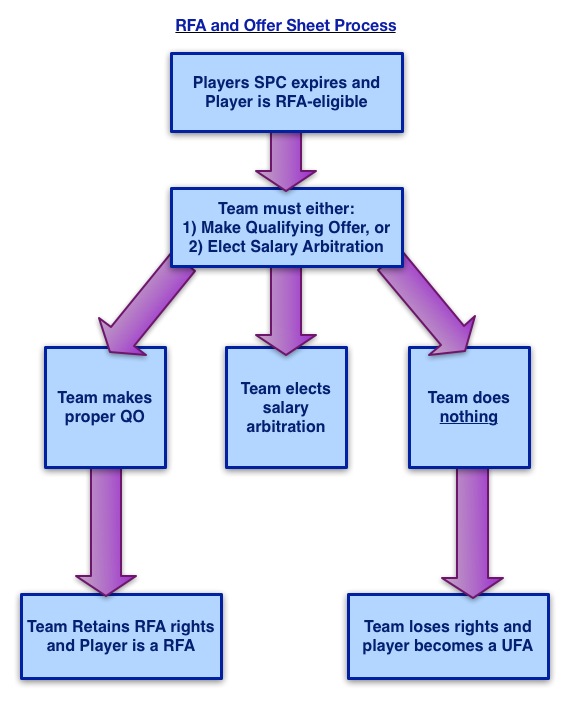Restricted Free Agents can sign with any team once their SPC expires, but the player’s prior club can either match the new contract—called an offer sheet—or receive compensatory draft picks from the RFA’s new team. It allows a young player the opportunity to experience free agency while giving teams a exclusive chance to match any offer their player may receive.
Who is Eligible to be an RFA?
A player generally becomes an RFA after his first contract expires. Essentially, RFA status is tied to a player’s age* when he signed his first SPC:
18-21 when signing ELC: RFA after 3 years of pro experience
22-23 when signing ELC: RFA after 2 years of pro experience
24+ when signing ELC: RFA after 1 year of pro experience
Age is defined as the players age on September 15th of the year he signed his first SPC. Professional experience however, depends on a player’s age. For players 18 and 19, professional experience is 10+ games in the NHL. For players 20+, professional experience is merely 10+ games in any professional league.
Just because a player is eligible to be an RFA, however, does not automatically bestow RFA status. As explained below, a team must either make the player a Qualifying Offer (QO) or elect to take the player to salary arbitration. If a team does neither, the player becomes a UFA.
Flowchart Illustraing NHL RFA Timeline
What is a Qualifying Offer?
A qualifying offer (QO) is an offer of a one year SPC by a player’s team. The CBA requires that the SPC meet certain terms and conditions:
Salary
An SPC’s minimum salary is determined by a player’s previous year’s NHL Salary
- If a player’s previous year’s NHL salary was $660,000 or less, the SPC must offer a minimum of 110% of the player’s previous year’s salary;
- If a player’s previous year’s NHL salary was greater than $660,000 but less than $1,000,000, the SPC salary must be at least 105% of the player’s previous salary but cannot exceed $1,000,000; or
- If a player’s previous year’s NHL salary was equal to or greater than $1,000,000, then the SPC salary must be 100% of the player’s previous salary.
One-way and Two-way
Most QOs are two-way (meaning that the player receives a minor league salary if he is sent down). A QO must be one-way, however, if the player meets the following conditions:
- played at least 180 NHL games in the previous three NHL seasons;
- played at least 60 NHL games in the previous season; and
- did not clear waivers during the regular season waiver period.
Qualifying offers sheets are predominantly a formality. Teams are required to make an offer so they can retain a player’s RFA rights. Players can reject a team’s QO—something they usually do. Once the QO expires, both the team and the player will negotiate a more lucrative deal.
When Does a Team Make a Qualifying Offer?
A team seeking to retain its rights in RFA players (and not electing arbitration) must tender the QO by the later of June 25th or the first Monday after the NHL Entry Draft. That means that a player must receive the offer by that date. A late QO is insufficient, and the player immediately becomes a UFA.*
When Can a Player Accept a Qualifying Offer?
Even though a QO must be offered in June, a player cannot accept a QO until July 1st. The QO is open for two weeks until it expires on July 15th.
What if a Team does not Make a Qualifying Offer?
If a team does not make a Qualifying Offer by the CBA-imposed deadline, the RFA-eligible player immediately becomes an unrestricted free agent.
So an RFA either receives a QO, or becomes a free agent. If they receive a QO, they can still sign with another team, but their original team has right of first refusal. This process is called the offer sheet process. See our forthcoming post on offer sheet soon.
* in 2010, the Chicago Blackhawks tendered their QOs late, and their RFA-eligible players became UFAs
